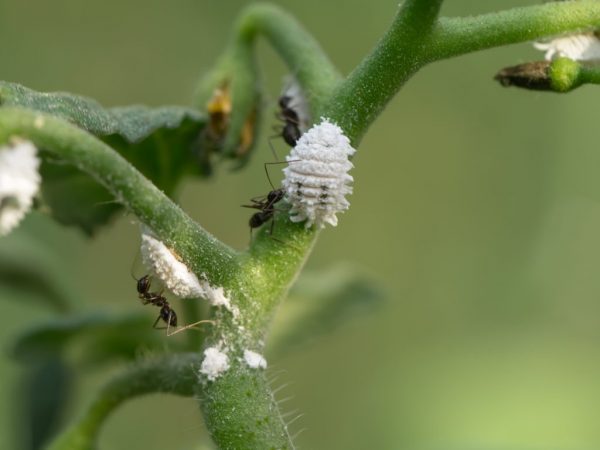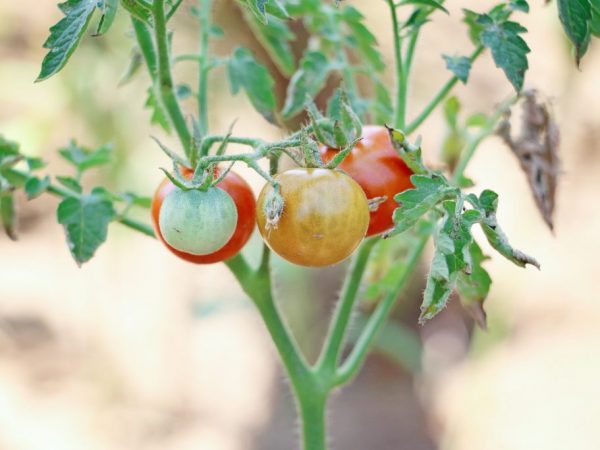How to deal with aphids on tomatoes
When growing tomatoes in the garden, summer residents are often faced with various pests that destroy the tomato crop. A common insect that attacks a vegetable crop and is capable of pretty spoiling vegetables is aphid on tomatoes.

Aphid control on tomatoes
What is harmful to aphids
What aphids look like can be found in various photos. A member of the Coleoptera order, this is a small insect actively settling on tomatoes, no more than 7 mm in size. With her proboscis, she pierces a leaf of a tomato plant and sucks out their juice. By releasing a sweet liquid called honeydew, aphids attract ants and other insects to tomato bushes that harm the vegetable crop.
Among the numerous species of aphids, there are winged insects and individuals without wings.
Adult aphids on tomatoes emerge from larvae during the warm spring period. These larvae hatch from eggs laid on the plant in autumn. After the transferred molt, the young larvae begin to feed on the juices of young tomatoes, as a result of which they are depleted. The larvae reproduce, acting as the source of the appearance of wingless females of aphids. For the entire gardening season, aphids on tomatoes can reproduce up to three generations, with a total of several hundred thousand individuals.
Over time, the stems of tomatoes become tough. This is the period for winged aphids to appear on tomatoes. Flying from bush to bush, it activates the processes of reproduction.
As a result of the activity of aphids on tomatoes, the growth of a vegetable crop slows down until its growth stops completely. At the same time, at the stage of fully ripe tomatoes, aphids attacking tomatoes are not harmful, however, at the stage of tomato flowering, pest colonies that appear cause the loss of the entire tomato crop.
Aphids that have settled on tomatoes can cause the death of cucumbers and other vegetable crops planted nearby in a greenhouse or open field.
Which indicates aphids
The initial signs of aphids on tomatoes can be found in the lower part of the bushes, on the succulent leaves and stems of tomatoes planted in open ground or in a greenhouse. Among the first symptoms of tomato aphid infestation:
- change in the shape of the leaf plate, deformation of the ovaries and young shoots, if the leaves of tomato aphids are damaged, they begin to curl,
- drying of leaves, ovaries, shoots and their subsequent shedding,
- the presence of a sticky bloom (dew) on the foliage and the fruits of tomatoes themselves,
- accumulation of ants in large numbers around tomato bushes,
- delay and complete cessation of the growth of tomato seedlings.
Often, aphids on tomato leaves can be detected with the naked eye. To do this, it is enough just to carefully consider the back side of the leaf blade. Aphids affecting tomato seedlings and adult bushes can be of several types:
- potato aphids on tomatoes - red or green, affecting vegetables and in a greenhouse outdoors,
- root white - translucent with a pink or brown tint, practically indistinguishable in the ground, retains its vital activity in the upper layer of the soil, leaving eggs there for wintering, it destroys the plant stem directly at the base, disrupting the process of organic matter and water flow up the plant, which causes drying and death of tomatoes,
- melon - painted in light and dark green shades in black, black aphids on tomatoes appear in the greenhouse at the onset of summer, and on the bushes planted in the open field, they move to the middle of the summer season,
- peach, or tobacco, greenhouse, - starts on peach trees, but with reproduction and an increase in the population, it moves to nearby growing tomato bushes, returning to the end of the gardening period for wintering again on trees.
How to deal with aphids

There are several ways to fight aphids.
Possible remedies for dealing with aphids on tomatoes include mechanical methods, biological techniques, and chemicals. Many gardeners tend to use folk remedies to destroy aphids.
Mechanical methods
The physical method of controlling aphids on tomatoes involves manual cleaning of the vegetable crop from the pest. In this case, each leaf plate is examined for the presence of aphid larvae and adults from the outside. It is possible to destroy aphids by washing the tomato bushes with a watering hose. Do this cleaning procedure with water for several days in a row.
Biological techniques
Biology in the fight against black aphids on tomatoes comes down to attracting birds that feed on insects to the site. For this purpose, drinkers are hung up. Among the natural enemies of aphids are also larger representatives of the order of insects that eat its larvae. These are flies and wasps, ladybugs and lacewings.
Chemical activities
In the fight against insects, they actively use insecticidal agents for aphids on tomatoes specially designed for this, through which they poison the insect. Any contact with an insecticide leads to death. Chemical methods of processing vegetable crops are especially resorted to when growing on a large scale, since using folk remedies and mechanical methods, the pest can be dealt with only in small areas. Among the insecticides often used in the fight against aphids on tomatoes, which are recommended to be sprayed on plants, are aktara, inta-vir, fitoverm and others.
Folk possibilities
Among the folk remedies, how can one deal with black and white aphids and other types of pests, the most effective are shown:
- ash solutions with laundry soap, they are required to spray the plants in the evening in dry weather, the absence of sunlight will save them from burns, and in the absence of rain, all the solution that got during spraying will remain on the leaves and stems,
- wormwood and garlic in the form of tinctures and decoctions, as well as pepper and celandine, which can scare away individuals from tomatoes with their pungent smell, which the pest does not like, it is recommended to spray tomatoes with these herbs several times, but gardeners are not afraid to fight the pest with this method often, since these folk remedies are safe for the vegetable crop,
- soda in combination with garlic, a solution with it is required to process the plants in dry time, so that the rain does not wash off the treatment,
- ammonia together with laundry soap, diluted with water, it will not only allow you to fight aphids, but also help fertilize tomatoes with nitrogen, it is recommended to process them several times,
- tobacco, a tincture is made from it, which repels aphids with a smell and leads to its death, although it takes a long time to spray it with tobacco, however, it acts as an effective way in the fight against the pest to get rid of the larvae and adults.
Preventing aphid infestation
The best method to keep the tomato crop from aphids is to take timely measures and take preventive measures. Among the most commonly used by experienced gardeners ways to deal with insects:
- periodic inspection of tomato bushes for pests that have settled, especially attention should be paid to the underside of the leaf blades,
- conducting regular ventilation of the greenhouse in which the tomatoes are planted, maintaining the required air temperature and humidity,
- getting rid of ants at their summer cottage, which lead aphids to a vegetable crop,
- planting near tomato beds those crops that the harmful insect is afraid of, among them - carrots, garlic and onions, parsley and dill, you can plant herbs, including lavender and thyme,
- avoiding an oversupply of soil fertilization with nitrogen baits,
- liming the soil for the winter, the introduction of lime kills the eggs of the pest preserved in the soil,
- cleaning the remains of vegetation, which can serve as a place for keeping aphid eggs until the next warm season.
When the primary signs of the presence of aphids on tomatoes are detected, the right method is selected to combat the pest, through which you can immediately spray and effectively destroy aphids and save the harvest of planted tomatoes. Gardeners give preferences to folk remedies.


